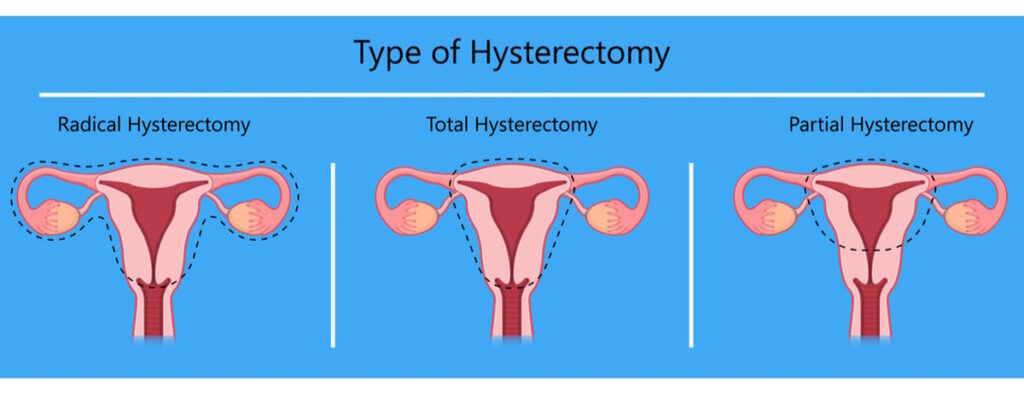A hysterectomy has historically been the surgical answer many gynecologists turn to with patients who suffer from uterine fibroids and the complications that arise from them. Approximately 600,000 hysterectomies are still being performed annually in the United States. By 60, one in every three women will have one.
For some women, a hysterectomy may be the right option for their unique situation. That said, what’s important to note here is that while having a hysterectomy can improve your fibroid situation, many women may not realize how drastically it affects their bodies—or that they have less invasive options to consider.
Perhaps a few of these questions are running through your mind right now: Is a hysterectomy right for me? Is it my only option? How could it affect my health? Before you move forward, consider all the facts.
Has Your Doctor Recommended a Hysterectomy to Relieve These Symptoms of Fibroids?
- Debilitating cramps, pelvic pain, and pressure
- Periods that last longer than a week
- Heavy menstrual bleeding
- Weight gain or bloating and swelling in the abdomen
- Back or leg pain
- Pain during sex
- Urinary frequency
- Constipation, diarrhea, and rectum discomfort
- Excessive fatigue coupled with anemia
[Insert CTA] A hysterectomy may not be your only solution to fibroid discomfort. Schedule a consult at Fibroid Institute Texas, with locations in Dallas and Houston. [button]
Tell Me More About Fibroids and a Hysterectomy
A hysterectomy is a way to treat fibroids as well as unrelated threats of cancer. It is effective for fibroids because everywhere these noncancerous muscular growths could possibly grow and cause discomfort has now been removed. This can include all or part of a woman’s uterus and, in some cases, the fallopian tubes and ovaries. It is currently the second most common gynecologic surgery after C-section.
A hysterectomy can be performed through the vagina, abdomen, or laparoscopically, and there is almost no chance of fibroids returning after this procedure. Your doctor may recommend one of three types of hysterectomies:
- Partial hysterectomy — In this surgery, only part of the uterus and possibly the ovaries are removed. The cervix is left intact, but the patient still will not be able to bear children. After a partial hysterectomy, where the ovaries stay, it is possible that a woman’s ovaries could keep producing hormones until menopause.
- Total hysterectomy — Also known as a complete hysterectomy, this is the most common type of hysterectomy and involves removing all of the uterus, the cervix, and possibly the fallopian tubes and ovaries. Eligible candidates typically have fibroids embedded in multiple areas or have a threat of cancer. Many women no longer need to get an annual Pap test if the cervix is removed. However, they should continue to have regular pelvic examinations.
- Radical hysterectomy — This procedure is reserved for extreme cases where cervical or uterine cancer is present. It involves removing the uterus, the cervix and its surrounding tissue, and the upper part of the vagina. Usually, the fallopian tubes and the ovaries are removed.

Is a Hysterectomy Right for Me?
While there is almost no chance of fibroids returning after having a hysterectomy, there are several factors women need to know before making such a big health decision. For starters, the recovery time can be six weeks or longer, depending on your situation. And because there is no uterus, having children in the future is no longer an option.
Besides the reproductive limitations, a hysterectomy could also disrupt your life in any of the following ways:
- Changes in sexual feelings or sensations
- Menopausal symptoms
- Hormonal changes
- Depression over loss of fertility and body changes
The risks don’t stop there. According to the National Library of Medicine, 29 relevant studies evaluating the long-term impact of a hysterectomy were performed between 2005 and December 2020. A quick review showed that this procedure may increase the risk of cardiovascular events, certain cancers, the need for further surgery, early ovarian failure and menopause, depression, and other outcomes. The study most widely cited among medical journals is Laughlin-Tommaso et al. 2017, which states women who underwent a hysterectomy at age 35 years had a 4.6-fold increased risk of congestive heart failure and a 2.5-fold increased risk of coronary artery disease.
Her team of researchers identified 2,094 women who underwent a hysterectomy with ovarian conservation (the ovaries were saved) between 1980 and 2002 and found they were more likely to develop hyperlipidemia, hypertension, obesity, cardiac arrhythmias, and coronary artery disease.
The Mayo Clinic noted that Dr. Laughlin-Tommaso’s findings were in younger women. Those aged 50 and older didn’t appear to have an increased risk of cardiovascular disease and metabolic conditions. That said, previous research from the Nurses’ Health Study published in 2009 had shown a 17% increased risk of coronary heart disease after hysterectomy with removal of ovaries, compared with hysterectomy leaving the ovaries in place. This new study shows that women who underwent a hysterectomy had a:
- 14% increased risk of high blood fat levels
- 13% increased risk of high blood pressure
- 18% increased risk of obesity
- 17% increased risk of irregular heartbeats, and
- 33% increased risk of coronary artery disease
The Mayo Clinic added that researchers say Laughlin-Tommaso’s study overcomes several limitations of prior studies, including the fact that they could detect more cardiovascular disease events compared with other studies where follow-up was limited to 10 or fewer years.

The Good News: A Hysterectomy Isn’t Your Only Option
A hysterectomy or another invasive, painful surgery isn’t your only option to treat uterine fibroid issues. If your doctor says it’s the only option, it is wise to seek a second opinion.
Many women have found relief from painful uterine fibroids through the following surgical alternatives:
- Medications — These can help with some of your symptoms but won’t get rid of your fibroids.
- Acessa — A small probe is placed into a fibroid and heated up to destroy it. If you have multiple large fibroids or fibroids that are hard to get to, Acessa is not the best choice. It is also not covered by some insurance companies.
- Endometrial Ablation — This technique removes the inside lining of the uterus to reduce heavy bleeding. However, it is not a good option if you want to get pregnant in the future. It also won’t shrink fibroids or treat fibroids outside the interior uterine lining.
- Sonata System — Using an intrauterine ultrasound device, radiofrequency energy shrinks the fibroid. Studies show Sonata works with non-pedunculated submucosal fibroids and fibroids larger than 5.0 cm may require the application of multiple ablations.
- Uterine Fibroid Embolization (UFE) — A minimally invasive procedure that cuts off blood flow to all fibroids, causing them to shrink and die. UFE is provided by a specialized fibroid doctor known as an interventional radiologist. It is low risk, doesn’t require incisions, and is faster than some of the other alternatives.
UFE is one of the most reliable ways to treat fibroids for women who qualify. During a UFE procedure, a tiny tube is fed through the blood vessels right to the uterus, and the blood flow to all the fibroids is blocked from the inside. With blood flow having been cut off, the fibroid will shrink and die. Thus, the patient will experience a fast reduction in painful symptoms.
Patients go home the same day, and the recovery time is usually 7-10 days—much less than a hysterectomy.

Additional advantages of UFE at Fibroid Institute
- Non-surgical, minimally invasive treatment option for fibroids
- Uterus remains preserved
- Recovery time only 7-10 days versus 4-6 weeks for surgery
- In-office procedure instead of hospital stay
- Tiny wrist puncture, no need for vaginal access
- All fibroids may be treated at the same time
- Avoids side effects of hormone therapies typically used to treat fibroids
- Over 90% of patients see dramatic improvement in symptoms
- Five-star doctors as rated by patient reviews
- 24/7 access to physicians during treatment
Don’t Suffer With Uterine Fibroids. Our Fibroid Experts Can Help!
Uterine fibroids can cause painful and life-altering symptoms for many women, especially as fibroids grow and put more pressure on your uterus. While a hysterectomy used to be the best answer to improve a woman’s quality of life, it’s no longer the only option on the table.
At Fibroid Institute Texas, we don’t believe you need to decide between suffering in silence or having a hysterectomy. That is why we are dedicated to treating fibroids using uterine fibroid embolization (UFE), the gold standard in non-surgical fibroid treatment. With multiple locations, our Houston and Dallas fibroid clinics help thousands of women avoid fibroid surgery and find relief from their fibroid symptoms.
Our fibroid doctors are board-certified interventional radiologists and experts passionate about helping women become #FibroidFree. Request a free 10-15 minute phone screening to determine if you are eligible. After the screening, if you qualify for UFE, you can schedule your onsite or telehealth consultation.
Most major medical insurance providers cover the cost of UFE. Get started now with Fibroid Institute Dallas at 214-838-6440 or with Fibroid Institute Houston at 713-903-3733 or complete the form below.
Fibroid Institute Texas serves the Dallas and Houston areas including Houston, Sugar Land, Katy, Webster, The Woodlands, Universal City, Spring, Kingwood, Stafford, Conroe, Texas City, Cypress, League City, Bellaire, Addison, Carrollton, Plano, Frisco, McKinney, Allen, Fort Worth, Grand Prairie, HEB, Arlington, Hutchins, Irving, Duncanville, DeSoto, Cedar Hill, Lancaster, Cockrell Hill, Highland Park, University Park, Park Cities, Garland, Mesquite, Richardson, Dallas, Sherman, and more.
This information is not a substitute for professional medical advice. Prior to starting any new treatment or if you have questions regarding a medical condition, always seek the advice of your doctor or other qualified health provider.
*Patient stories are true. Names and/or photos may be changed to protect patient confidentiality.

